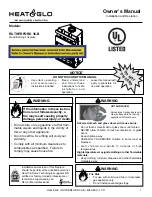
5
CREOSOTE
When wood burns slowly, it produces tar and other organic vapours, when associated with moisture, creosote forms. The
creosote vapour condenses in a chimney pipe relatively cooled by a slow fire. It results in an accumulation of creosote
inside the pipe.
When burning creosote forma a blazing fire.
It is preferable to make small brisk fires rather than large smouldering ones. This will enable you to keep the chimney and
glass clean.
It is important to inspect the chimney or clean it periodically.
WOOD
Avoid using green wood to slow down combustion. This causes the formation of excessive soot and creosote deposit in
the chimney. It may cause a chimney fire. An accumulation of more than 3mm of creosote is sufficient to proceed to the
cleaning of the chimney in order to reduce the risks of a chimney fire.
It is important to burn seasoned wood to obtain a better quantity of heat per cordwood.
Burn reasonable loads, do not overload the stove and ensure that the logs are placed in order not to fall against the glass,
or to burn too close to the glass.
Use seasoned wood only. Note that
6-12
months are needed for drying to have seasoned wood of
15 to 20 %
of moisture.
Important
: Do not store wood near stove.
MANUFACTURED LOGS
The manufactured logs or eco logs can be use can be used in air-tight wood heating appliances only if they are made of
100% compressed wood residues. The manufactured logs who use chemical additives should under no circumstances be
used as fuel, because they produce a much more intense heat that can damage your device and avoid warranty. The
manufactured logs who are made with 100% compressed wood residues should be used with caution. In general, this type
of log produces a high heat for a short period of time. The appliance could overheat if too much log is use simultaneously.
It is recommended to start the ignition with a single log.



































